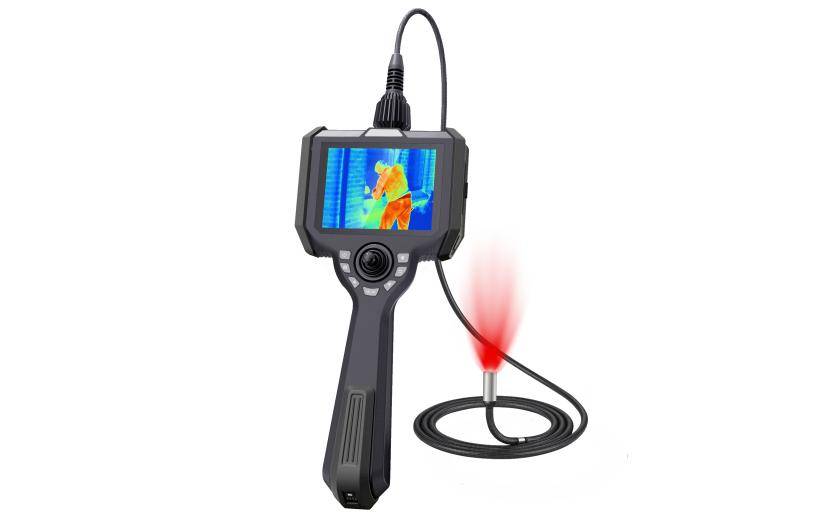Want to know more?
Don't miss any product updates on our industrial borescopes

Industrial borescope
solution service provider
Company Address
Office : 18F, Pingshanshouzuo, Pingshan District, Shenzhen,Guangdong
Contact Info
Ph: +86-0755-89588241

Industrial endoscope infrared and thermal imaging technologies are two advanced non-destructive testing technologies, which play an important role in industrial inspection, safety monitoring and other fields. The following is a detailed introduction to these two technologies:

Technical overview
Industrial endoscope infrared technology is a detection method that combines industrial endoscopes with infrared thermal imaging technology. It uses infrared detectors to capture infrared radiation emitted from the surface of an object, and after system processing, it converts these invisible infrared energies into visible thermal images, and uses the probe of the endoscope to penetrate deep into the equipment to achieve intuitive observation of the temperature distribution of the target area.
Working Principle
The working principle of infrared thermal imaging endoscope is based on the thermal effect of infrared radiation. All objects above absolute zero will emit infrared radiation, and its intensity is directly related to the temperature of the object. The infrared thermal imaging endoscope receives these radiations through optical lenses and infrared detectors, and after a series of signal processing, it converts the temperature information into colorful thermal images. These images represent different temperature ranges with different colors, allowing inspectors to observe the temperature distribution of the object being tested at a glance.
Main features
Non-contact temperature measurement: avoids the errors and contamination that may be caused by traditional contact temperature measurement, and improves the accuracy and safety of measurement.Clear imaging: High-resolution infrared thermal images can clearly show the temperature details of the measured object, making it easy to quickly identify problem areas.Wide range of applications: Suitable for various industrial environments, including high temperature, toxic, nuclear radiation and places that cannot be directly observed by the human eye.
Application areas
Power industry: Used to detect thermal imaging of generators, transformers, cables and other equipment, and timely detect and deal with thermal faults.
Petrochemical industry: Monitor the working status of equipment such as pipelines and storage tanks, and discover safety hazards such as internal leakage.
Machinery manufacturing industry: Detect thermal imaging of motors, bearings and other parts to evaluate their working status and life.

Technical overview
Thermal imaging technology is a technology that uses the principle of infrared radiation to measure the surface temperature of an object non-contactly and display it visually in the form of an image. It is widely used in industrial detection, safety monitoring, medical diagnosis and other fields.
Working principle
Thermal imaging technology uses infrared detectors to receive infrared radiation emitted by the surface of an object, and after signal processing, the temperature information is converted into a visible thermal image. These images represent different temperature ranges in different colors, allowing inspectors to visually observe the temperature distribution of the object being measured.
Main features
Real-time: It can capture and display the temperature distribution of the surface of an object in real time, providing strong support for quick decision-making.
Accuracy: Through high-precision infrared detectors, it can accurately measure the temperature of the surface of an object and improve the accuracy of detection.
Intuitive: Display the temperature distribution in the form of images, so that the inspector can observe the problem area at a glance.
Application areas
Security monitoring: At night and in severe weather conditions, thermal imaging technology can penetrate obstacles such as smoke and haze, clearly capture the thermal image of the target object, and provide strong support for security prevention.
Forest fire prevention: Real-time monitoring of forest fires, timely discovery and determination of the location and scale of the fire point, and win precious time for fire control and firefighting.
Environmental monitoring: Used for the detection and analysis of environmental pollutants, such as industrial waste gas emissions, garbage incineration, etc., to provide a scientific basis for environmental protection.
In summary, industrial endoscope infrared and thermal imaging technologies are two advanced non-destructive testing technologies, which have broad application prospects and great practical value in the fields of industrial detection, safety monitoring, etc. With the continuous advancement of science and technology and the continuous expansion of applications, these technologies will contribute more wisdom and strength to industrial development.
Shenzhen Vsndt Co., Ltd has rich experience in internal visual inspection and industrial endoscope product development. We can customize industrial endoscope products according to customer needs. If you have any needs for industrial endoscopes, please feel free to contact us.

Industrial borescope
solution service provider